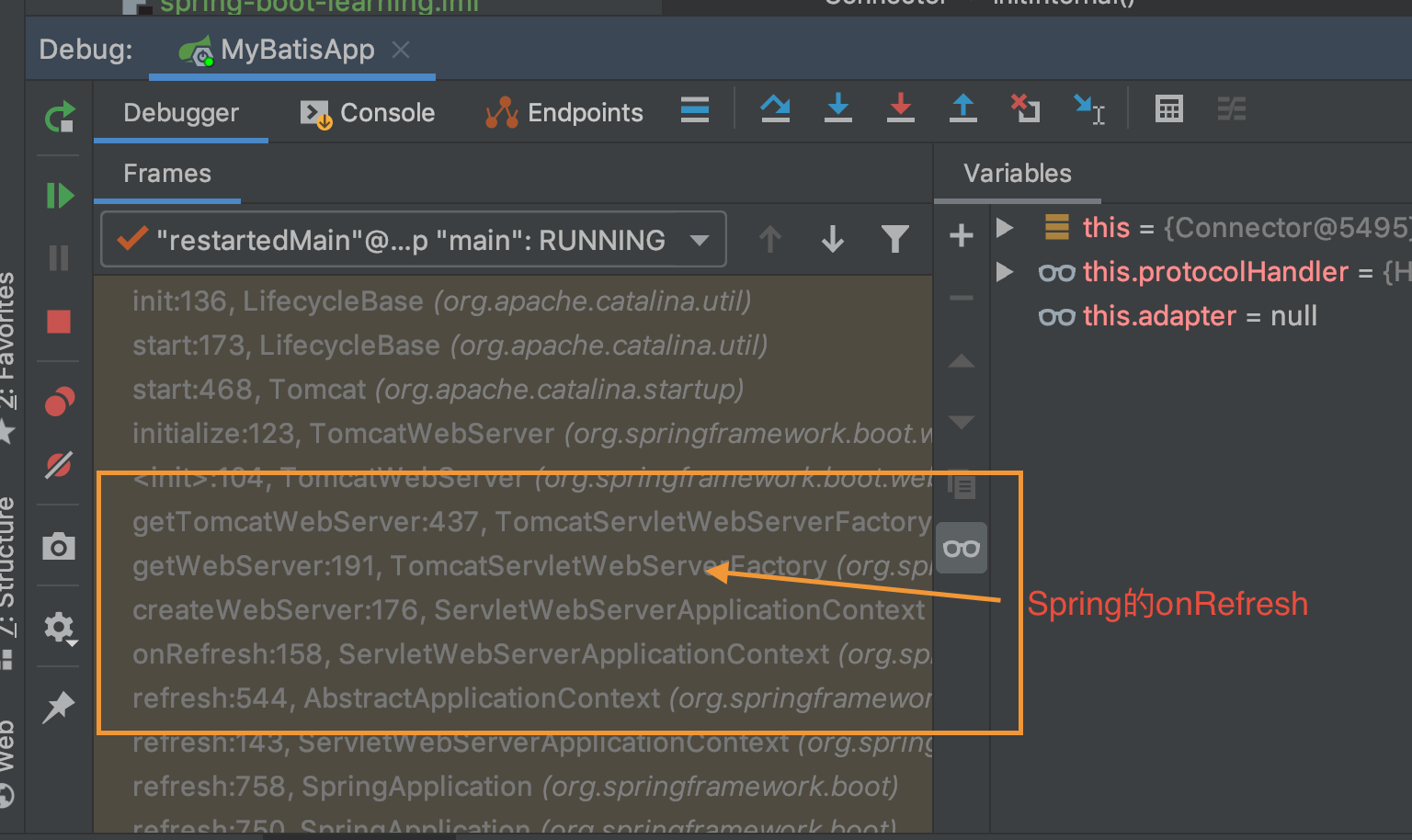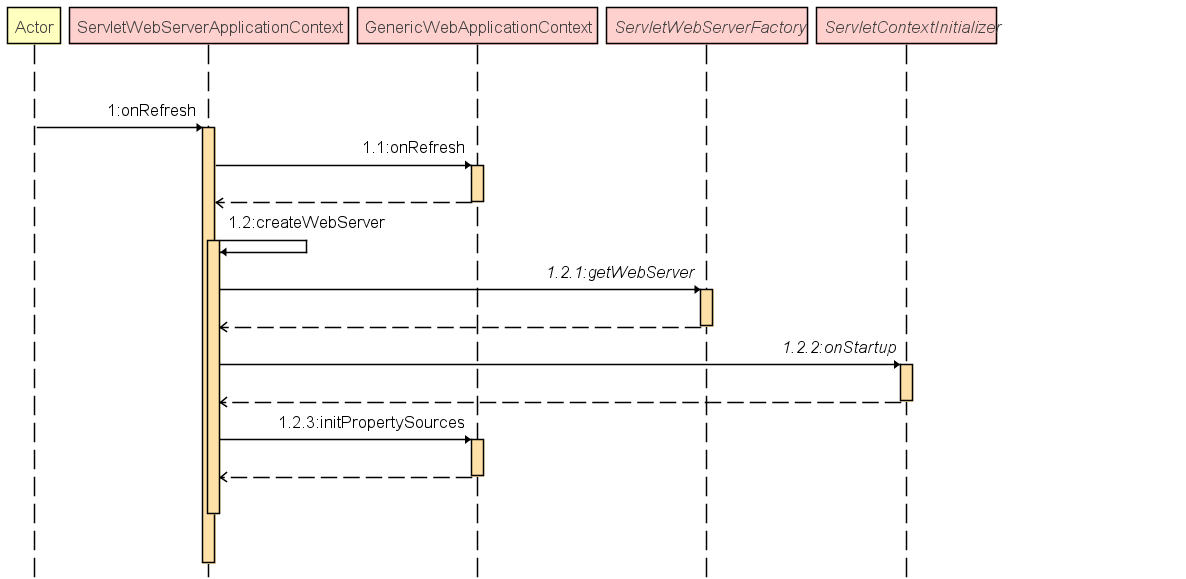Spring Boot一个非常突出的优点就是不需要我们额外再部署Servlet容器,它内置了多种容器的支持。我们可以通过配置来指定我们需要的容器。
本文以我们平时最常使用的容器Tomcat为列来介绍以下两个知识点:
- Spring Boot是怎么整合启动Tomcat容器的;
- 在Spring Boot中,怎么进行Tomcat的深度配置。
Spring Boot整合启动Tomcat的流程
对于看源代码,每个人都有自己的方法。我自己在看源代码的时候喜欢结合IDEA的Debug功能一起看。比如说现在我们要研究Spring Boot是在哪个环节点启动Tomcat的,
我的思路是:Tomcat在启动时会调用各个组件的init方法和start方法,那么我只需要在这些方法上打上端点,然后就能在调用栈上看出Spring Boot是在哪个环节点启用
Tomcat的了。
按照这个思路,我在Tomcat的Connector组件的init方法上打了端点,通过调用栈能很清楚的看出Spring Boot是在容器的onRefresh方法中调用Tomcat的。
protected void onRefresh() {
super.onRefresh();
try {
this.createWebServer();
} catch (Throwable var2) {
throw new ApplicationContextException("Unable to start web server",var2);
}
}

找到了调用点,那么一切都好办了。从上面的方法中可以看出,重点内容就在this.createWebServer()这个方法中。
在Spring Boot中使用的容器类是ServletWebServerApplicationContext系列的容器,这个系列的容器可以内嵌Web容器。这个我们
可以从这个容器的属性和方法中可以看出来。
public class ServletWebServerApplicationContext extends GenericWebApplicationContext implements ConfigurableWebServerApplicationContext {
//...省略部分代码
public static final String DISPATCHER_SERVLET_NAME = "dispatcherServlet";
//内嵌容器
private volatile WebServer webServer;
private ServletConfig servletConfig;
//...省略部分代码
//创建Web容器
private void createWebServer() {
WebServer webServer = this.webServer;
ServletContext servletContext = this.getServletContext();
//webServer和servletContext都是null,表示还没创建容器,进入创建容器的逻辑
if (webServer == null && servletContext == null) {
//获取创建容器的工厂,可以通过WebServerFactoryCustomizer接口对这个工厂进行自定义设置
ServletWebServerFactory factory = this.getWebServerFactory();
//具体的创建容器的方法,我们进去具体看下
this.webServer = factory.getWebServer(new ServletContextInitializer[]{this.getSelfInitializer()});
} else if (servletContext != null) {
try {
this.getSelfInitializer().onStartup(servletContext);
} catch (ServletException var4) {
throw new ApplicationContextException("Cannot initialize servlet context",var4);
}
}
this.initPropertySources();
}
}
下面是TomcatServletWebServerFactory的getWebServer方法。
public class TomcatServletWebServerFactory的getWebServer{
//...
@Override
public WebServer getWebServer(ServletContextInitializer... initializers) {
//创建Tomcat容器
Tomcat tomcat = new Tomcat();
File baseDir = (this.baseDirectory != null ? this.baseDirectory
: createTempDir("tomcat"));
tomcat.setBaseDir(baseDir.getAbsolutePath());
//创建连接器,默认NIO模式,可以通过WebServerFactoryCustomizer改变具体模式
Connector connector = new Connector(this.protocol);
tomcat.getService().addConnector(connector);
//自定义连接器
customizeConnector(connector);
tomcat.setConnector(connector);
tomcat.getHost().setAutoDeploy(false);
configureEngine(tomcat.getEngine());
//可以通过WebServerFactoryCustomizer添加额外的连接器,这边将这些连接器绑定到Tomcat
for (Connector additionalConnector : this.additionalTomcatConnectors) {
tomcat.getService().addConnector(additionalConnector);
}
//组测Listener、Filter和Servlet,自定义Context等操作
//这个方法可以重点看下
prepareContext(tomcat.getHost(),initializers);
//创建TomcatWebServer,并调用start方法
return getTomcatWebServer(tomcat);
}
//内嵌的Tomcat容器
public TomcatWebServer(Tomcat tomcat,boolean autoStart) {
Assert.notNull(tomcat,"Tomcat Server must not be null");
this.tomcat = tomcat;
this.autoStart = autoStart;
//这边触发Tomcat的启动流程,是Tomcat启动的入口点
initialize();
}
//...省略部分代码
}

至此Spring Boot内嵌的Tomcat已将顺序启动了。那么Spring Boot是在什么时候注册DispatchServlet的呢?
配置Listener、Filter和Servlet
Spring Boot配置Listener、Filter和Servlet可以參考我之前写的文章Spring Boot使用嵌入式容器,那怎么配置自定义Filter呢
推荐使用ServletListenerRegistrationBean、FilterRegistrationBean和ServletRegistrationBean的方式注册Listener、Filter和Servlet。
Spring Boot注册DispatcherServlet
在传统的Spring MVC项目中,我们都会在web.xml中注册DispatcherServlet这个入口类,那么在Spring Boot中是在哪里注册的呢?
大家如果看Spring Boot的源代码,这边有个小技巧大家可以参考下。就是Spring Boot把之前传统项目中的配置项都通过AutoConfig的形式
做配置了。所以这边在寻找DispatcherServlet是在哪里配置的也可以顺着这个思路去寻找。
在IDEA的类查找功能中输入DispatcherServlet关键字,我们能看到一个DispatcherServletAutoConfiguration类。从名字上就能看出这个
类是DispatcherServlet的自动配置类,我们点进去看下是否是在这个类内部注册的DispatcherServlet?
@AutoConfigureOrder(Ordered.HIGHEST_PRECEDENCE)
@Configuration
@ConditionalOnWebApplication(type = Type.SERVLET)
@ConditionalOnClass(DispatcherServlet.class)
@AutoConfigureAfter(ServletWebServerFactoryAutoConfiguration.class)
@EnableConfigurationProperties(ServerProperties.class)
public class DispatcherServletAutoConfiguration {
/*
* The bean name for a DispatcherServlet that will be mapped to the root URL "/"
*/
public static final String DEFAULT_DISPATCHER_SERVLET_BEAN_NAME = "dispatcherServlet";
/*
* The bean name for a ServletRegistrationBean for the DispatcherServlet "/"
*/
public static final String DEFAULT_DISPATCHER_SERVLET_REGISTRATION_BEAN_NAME = "dispatcherServletRegistration";
@Configuration
@Conditional(DefaultDispatcherServletCondition.class)
@ConditionalOnClass(ServletRegistration.class)
@EnableConfigurationProperties(WebMvcProperties.class)
protected static class DispatcherServletConfiguration {
private final WebMvcProperties webMvcProperties;
public DispatcherServletConfiguration(WebMvcProperties webMvcProperties) {
this.webMvcProperties = webMvcProperties;
}
@Bean(name = DEFAULT_DISPATCHER_SERVLET_BEAN_NAME)
public DispatcherServlet dispatcherServlet() {
DispatcherServlet dispatcherServlet = new DispatcherServlet();
dispatcherServlet.setDispatchOptionsRequest(
this.webMvcProperties.isDispatchOptionsRequest());
dispatcherServlet.setDispatchTraceRequest(
this.webMvcProperties.isDispatchTraceRequest());
dispatcherServlet.setThrowExceptionIfNoHandlerFound(
this.webMvcProperties.isThrowExceptionIfNoHandlerFound());
return dispatcherServlet;
}
@Bean
@ConditionalOnBean(MultipartResolver.class)
@ConditionalOnMissingBean(name = DispatcherServlet.MULTIPART_RESOLVER_BEAN_NAME)
public MultipartResolver multipartResolver(MultipartResolver resolver) {
// Detect if the user has created a MultipartResolver but named it incorrectly
return resolver;
}
}
@Configuration
@Conditional(DispatcherServletRegistrationCondition.class)
@ConditionalOnClass(ServletRegistration.class)
@EnableConfigurationProperties(WebMvcProperties.class)
@Import(DispatcherServletConfiguration.class)
protected static class DispatcherServletRegistrationConfiguration {
private final ServerProperties serverProperties;
private final WebMvcProperties webMvcProperties;
private final MultipartConfigElement multipartConfig;
public DispatcherServletRegistrationConfiguration(
ServerProperties serverProperties,WebMvcProperties webMvcProperties,ObjectProvider<MultipartConfigElement> multipartConfigProvider) {
this.serverProperties = serverProperties;
this.webMvcProperties = webMvcProperties;
this.multipartConfig = multipartConfigProvider.getIfAvailable();
}
//很熟悉的代码有没有,ServletRegistrationBean就是我们上一节中介绍的注册Servlet的方式
//只不过这边注册的是DispatcherServlet这个特殊的Servlet
@Bean(name = DEFAULT_DISPATCHER_SERVLET_REGISTRATION_BEAN_NAME)
@ConditionalOnBean(value = DispatcherServlet.class,name = DEFAULT_DISPATCHER_SERVLET_BEAN_NAME)
public ServletRegistrationBean<DispatcherServlet> dispatcherServletRegistration(
DispatcherServlet dispatcherServlet) {
ServletRegistrationBean<DispatcherServlet> registration = new ServletRegistrationBean<>(
dispatcherServlet,this.serverProperties.getServlet().getServletMapping());
registration.setName(DEFAULT_DISPATCHER_SERVLET_BEAN_NAME);
registration.setLoadOnStartup(
this.webMvcProperties.getServlet().getLoadOnStartup());
if (this.multipartConfig != null) {
registration.setMultipartConfig(this.multipartConfig);
}
return registration;
}
}
//...省略部分代码
}
好了通过这边的介绍,我们直到DispatcherServlet是通过DispatcherServletAutoConfiguration这个自动配置类注册的。
Spring Boot中关于Tomcat的一些其他配置
server.tomcat.accept-count |
100.0 |
Maximum queue length for incoming connection requests when all possible request processing threads are in use.(backlog的长度) |
|---|---|---|
server.tomcat.accesslog.buffered |
true |
Whether to buffer output such that it is flushed only periodically. |
server.tomcat.accesslog.check-exists |
false |
Whether to check for log file existence so it can be recreated it if an external process has renamed it. |
server.tomcat.accesslog.condition-if |
Whether logging of the request will only be enabled if "ServletRequest.getAttribute(conditionIf)" does not yield null. | |
server.tomcat.accesslog.condition-unless |
Whether logging of the request will only be enabled if "ServletRequest.getAttribute(conditionUnless)" yield null. | |
server.tomcat.accesslog.directory |
logs |
Directory in which log files are created. Can be absolute or relative to the Tomcat base dir. |
server.tomcat.accesslog.enabled |
false |
Enable access log. |
server.tomcat.accesslog.encoding |
Character set used by the log file. Default to the system default character set. | |
server.tomcat.accesslog.file-date-format |
.yyyy-MM-dd |
Date format to place in the log file name. |
server.tomcat.accesslog.ipv6-canonical |
false |
Whether to use IPv6 canonical representation format as defined by RFC 5952. |
server.tomcat.accesslog.locale |
Locale used to format timestamps in log entries and in log file name suffix. Default to the default locale of the Java process. | |
server.tomcat.accesslog.max-days |
-1.0 |
Number of days to retain the access log files before they are removed. |
server.tomcat.accesslog.pattern |
common |
Format pattern for access logs. |
server.tomcat.accesslog.prefix |
access_log |
Log file name prefix. |
server.tomcat.accesslog.rename-on-rotate |
false |
Whether to defer inclusion of the date stamp in the file name until rotate time. |
server.tomcat.accesslog.request-attributes-enabled |
false |
Set request attributes for the IP address,Hostname,protocol,and port used for the request. |
server.tomcat.accesslog.rotate |
true |
Whether to enable access log rotation. |
server.tomcat.accesslog.suffix |
.log |
Log file name suffix. |
server.tomcat.additional-tld-skip-patterns |
Comma-separated list of additional patterns that match jars to ignore for TLD scanning. The special '?' and '*' characters can be used in the pattern to match one and only one character and zero or more characters respectively. | |
server.tomcat.background-processor-delay |
10s |
Delay between the invocation of backgroundProcess methods. If a duration suffix is not specified,seconds will be used. |
server.tomcat.basedir |
Tomcat base directory. If not specified,a temporary directory is used. | |
server.tomcat.connection-timeout |
Amount of time the connector will wait,after accepting a connection,for the request URI line to be presented. | |
server.tomcat.max-connections |
8192.0 |
Maximum number of connections that the server accepts and processes at any given time. Once the limit has been reached,the operating system may still accept connections based on the "acceptCount" property. |
server.tomcat.max-http-form-post-size |
2MB |
Maximum size of the form content in any HTTP post request. |
server.tomcat.max-swallow-size |
2MB |
Maximum amount of request body to swallow. |
server.tomcat.mbeanregistry.enabled |
false |
Whether Tomcat's MBean Registry should be enabled. |
server.tomcat.processor-cache |
200.0 |
Maximum number of idle processors that will be retained in the cache and reused with a subsequent request. When set to -1 the cache will be unlimited with a theoretical maximum size equal to the maximum number of connections. |
server.tomcat.redirect-context-root |
true |
Whether requests to the context root should be redirected by appending a / to the path. |
server.tomcat.relaxed-path-chars |
Comma-separated list of additional unencoded characters that should be allowed in URI paths. Only "< > [ \ ] ^ ` { | }" are allowed. | |
server.tomcat.relaxed-query-chars |
Comma-separated list of additional unencoded characters that should be allowed in URI query strings. Only "< > [ \ ] ^ ` { | }" are allowed. | |
server.tomcat.remoteip.host-header |
X-Forwarded-Host |
Name of the HTTP header from which the remote host is extracted. |
server.tomcat.remoteip.internal-proxies |
Regular expression that matches proxies that are to be trusted. | |
server.tomcat.remoteip.port-header |
X-Forwarded-Port |
Name of the HTTP header used to override the original port value. |
server.tomcat.remoteip.protocol-header |
Header that holds the incoming protocol,usually named "X-Forwarded-Proto". | |
server.tomcat.remoteip.protocol-header-https-value |
https |
Value of the protocol header indicating whether the incoming request uses SSL. |
server.tomcat.remoteip.remote-ip-header |
Name of the HTTP header from which the remote IP is extracted. For instance,X-FORWARDED-FOR. |
|
server.tomcat.resource.allow-caching |
true |
Whether static resource caching is permitted for this web application. |
server.tomcat.resource.cache-ttl |
Time-to-live of the static resource cache. | |
server.tomcat.threads.max |
200.0 |
Maximum amount of worker threads. |
server.tomcat.threads.min-spare |
10.0 |
Minimum amount of worker threads. |
server.tomcat.uri-encoding |
UTF-8 |
Character encoding to use to decode the URI. |
server.tomcat.use-relative-redirects |
false |
Whether HTTP 1.1 and later location headers generated by a call to sendRedirect will use relative or absolute redirects. |
这边给出一个配置的列子
server:
port: ${port:9999}
tomcat:
accept-count: 200
#最好进行这段配置,默认会在tmp目录下创建,Linux有时会有定时任务删除tmp目录下的内容
basedir: my-tomcat
accesslog:
enabled: true
pattern: '%t %a "%r" %s %S (%b M) (%D ms)'
max-http-post-size: 2MB
max-swallow-size: 2M
uri-encoding: GBK
threads:
max: 100
min-spare: 10
具体使用时可以参考Spring Boo官网关于Tomcat的配置。
一些其他类
Spring Boot还提供了很多自定义类,让用户对Tomcat的组件做自定义配置。这个符合Spring的设计哲学:只提供选择,而不是强制用户使用某项技术。
关于Tomcat的自定义配置类还有以下几个,大家可以按需使用。
- WebServerFactoryCustomizer接口:自定义Web容易工厂
- WebServerFactoryCustomizerBeanPostProcessor处理类:WebServerFactoryCustomizer类通过WebServerFactoryCustomizerBeanPostProcessor类生效
- TomcatConnectorCustomizer:连接器自定义处理类
- TomcatContextCustomizer:Context自定义接口
原文地址:https://www.cnblogs.com/54chensongxia
版权声明:本文内容由互联网用户自发贡献,该文观点与技术仅代表作者本人。本站仅提供信息存储空间服务,不拥有所有权,不承担相关法律责任。如发现本站有涉嫌侵权/违法违规的内容, 请发送邮件至 dio@foxmail.com 举报,一经查实,本站将立刻删除。

